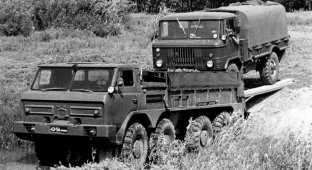Soviet experimental all-terrain vehicles ZIL, KrAZ and NAMI (39 photos)
In this publication we will mainly touch on the projects of the Likhachev Plant, but we will not limit ourselves to them and will study the most bizarre technical solutions that have not found serial application.
If the civilian Soviet automobile industry can be considered quite conservative, then in the construction of army all-terrain vehicles the USSR was, one might say, at the forefront of progress. Over the years, designers tested machines that had no analogues in the world with three and four drive axles, pneumatic rollers and pneumatic tracks, automatic transmissions, gas turbines and aircraft turbojet engines. We will tell you about the most striking experimental developments that remain bold ideas.
Under the conditions of the “Iron Curtain,” factory design bureaus often worked blindly, using popular science magazines and faded photographs of foreign new products. When the secrecy stamp was removed from these developments, the real picture of an exhaustingly difficult and sometimes amateur intuitive-scientific search for technical solutions, inept copying and reckless implementation of erroneous ideas began to emerge. The main product of that crazy activity, which took decades of desperate work and huge amounts of public money, were failed machines that remained amusing toys of their creators and useless ballast from the point of view of the country's defense.

Bet on three-axle vehicles
A rear-engine car on the chassis of the ZIS-157 prototype. 1956

A representative of the fiery generation of Soviet auto designers was Vitaly Andreevich Grachev, who headed the secret design bureau of the Moscow plant named after I. A. Likhachev (ZIL). Since the mid-1950s, he has been responsible for a variety of experimental military machines of various search systems. In the absence of his own experience and knowledge of the theory of off-road vehicles, he feverishly designed and tested his creations one after another in an attempt to intuitively find the truth in the sea of \u200b\u200bhis fantasies. One of Grachev’s areas of work was “light” three-axle vehicles, which were used to test units and test a number of components.
The first attempt to create a fundamentally new vehicle was a prototype on a trial chassis of the future ZIL-157 truck, built in the winter of 1956. Its revolutionary essence was to move the engine from the engine compartment to the rear of the frame to reduce the load on the front steered wheels. As often happens, the first pancake came out lumpy: the car lifted its “nose”, pushing a pile of snow in front of it, lost control and was not able to move at all on the virgin snow.
In the summer of 1956, a simple single-seat trolley ZIS-134E3 (aka Model No. 3) appeared with a wedge-shaped body and three drive axles with a single track. This scheme, with a uniform arrangement of axles along the length of the car, for a long time became the main conceptual direction for the development of all subsequent experimental Grachev vehicles. Its tests brought mixed results, giving its creators complete freedom of action and imagination.
Light experimental all-terrain vehicle ZIS-E134 Layout No. 3. 1956

Testing of a rear-engine bogie at the NIIAP test site in Bronnitsy

The following year, an experimental all-terrain vehicle ZIL-157R with front and rear steered wheels was built on the chassis of the ZIL-157 truck according to a scheme with equidistant axles. It had a 104-horsepower engine, a tire inflation system and power steering, and wide-profile or arched tires allowed the car to overcome ditches 2.5 m wide.
Experimental truck ZIL-157R with equally spaced axles. 1957

Flatbed 2.5-ton ZIL-157R vehicle on six arched tires

A 140-horsepower floating all-terrain vehicle ZIL-136, similar in concept, with a load-bearing hull and water-jet propulsion, took part in the same tests. For the first time, a simplified version of the onboard transmission with a lateral arrangement of drive bevel gears and cardan shafts was used for the first time for three-axle ZIL vehicles. At the rear of the car were placed a 140-horsepower gasoline engine and a gearbox from a ZIS-110 passenger car. The all-terrain vehicle was equipped with a system for changing tire pressure and power steering, elastic 20-inch or arched tires, but there was no suspension on it. During testing, it showed satisfactory maneuverability, but had poor handling.
Experimental floating all-terrain vehicle ZIL-136. 1957 (from the archives of the 21st Scientific Research Center)

ZIL-136 vehicle with a load-bearing frameless body and arched tires

In 1957, an experimental model of the three-axle armored vehicle BTR-E152V, structurally similar to the two previous models, was also built. It was equipped with front and middle steered wheels, a pneumatic power steering mechanism from the YaAZ-214 truck and hydraulic shock absorbers on all axles. The car could move forward or backward with one or two damaged wheels of the middle axle. The second sample with power steering had steering wheels on the front and rear axles with widened super-soft tires.
Grachev’s main achievement in the sector of three-axle vehicles was the next prototypes of land and amphibious trucks of the 132 series.
The original BTR-E152V with a 14-seat armored hull (from the archives of the 21st Scientific Research Center)

ZIL-132 family (1960–1976)
A bold attempt to create a whole family of army trucks of an unconventional concept was the production of all-wheel drive ZIL-132 vehicles, unified with the ZIL-131. Their main innovations were the use of a load-bearing base with a smooth bottom, an onboard transmission, evenly spaced pairs of wheels with adjustable internal pressure in large-diameter tires, and the complete absence of any suspension.
In the winter of 1960, a prototype of a 2.5-ton ZIL-132 bonnet truck with a cab, front facing and body from the ZIL-131 was assembled. For the first time, a ZIL-375 V8 gasoline engine with a power of 180 hp was installed on it. pp., which was later widely used on military vehicles. During testing, various types of tires were installed on the vehicle, and in March 1961, the manual gearbox was replaced with a hydromechanical automatic one. Externally, this option was distinguished by a van mounted on the loading platform for equipment and placement of testers. Alas, in September 1962, the car was destroyed in a fire.
Three-axle 2.5-ton truck ZIL-132 with a cab from ZIL-131. 1960

ZIL-132 family (1960–1976)
Variant of the three-axle all-terrain vehicle ZIL-132 on arched tires

ZIL-132 with automatic transmission and 24-inch tires. 1961

They remembered the ZIL-132 family only in the mid-1960s, when SKB received an order for a batch of PEU floating search and recovery units for searching and delivering returnable spacecraft. Then, on the units of the first PEU-1 vehicle, the ZIL-132P military amphibian was built, which was supposed to be opposed to the floating trucks of the Ural Automobile Plant. Its novelties were a torsion bar suspension of the outer wheels, a displacement hull on a welded frame, a fiberglass cabin and an aluminum alloy side body.
Experienced four-ton amphibious vehicle ZIL-132P. 1969

Rear view of the displacement hull and aluminum body

Unusual view of the ZIL-132P amphibian with the canopy removed (from the author’s archive)

On land the car reached 75 km/h, afloat with the help of a water cannon - 5–7 km/h. To facilitate exit from the water to shore, a VK-1A aviation turbojet engine was mounted in its body for the first time, which created additional traction force.
Testing of the 180-horsepower amphibious vehicle ZIL-132P on the Moscow River

First use of gas turbine auxiliary power unit

According to the same scheme, in 1974 they assembled the ZIL-132R land cabover five-ton truck, conceived as a multi-purpose army vehicle with high cross-country ability and maneuverability, capable of subsequently replacing the serial ZIL-131. Its new components were boosted to 165 hp. With. engine from a ZIL-130 car, aluminum frame, ventilated disc brakes, full-fledged independent torsion bar suspension on all wheels and a hydraulic follower for synchronized turning of the rear wheels. During testing, it reached a speed of 68 km/h and overcame fords 1.3 m deep.
Prototype of a five-ton cabover tractor-trailer ZIL-132R. 1974

Turning a ZIL-132R car with outer steered wheels

Testing of the ZIL-132R flatbed truck on rough terrain

Despite the sufficient power, the truck’s performance characteristics were almost no different from the ZIL-131 and was conditionally approved by the military with the condition that serious modifications be made, which would entail a significant alteration of the entire structure.
At the end of 1975, this car appeared in the guise of a ZIL-132RS agricultural truck with a ZIL-375 engine with a power of 180 hp. s., which a year later was converted into a ZIL-132RV truck tractor for operation as part of road trains with a total weight of 19 tons. It was tested at the 21st Research Institute, where it towed an active semi-trailer ZIL-137B without wheel drive, equipped with prototype equipment for transport vehicles of missile systems. Despite the improved performance compared to the active ZIL-137 road train, further work on the military use of 132-series vehicles was stopped.
Experienced multi-purpose three-axle truck tractor ZIL-132RV. 1976

Five-axle road train with overall weight model of a transport vehicle

Turbine instead of diesel
One of the pages of the history of Soviet military vehicles was written by unique heavy-duty trucks with gas turbine engines (GTE), which were a fashionable and promising trend at that time. For the first time such a car was assembled by the Bryansk Automobile Plant in 1968. It was a four-axle special chassis E135G for missile systems with a gas turbine with a power of 395 hp. With. Then, under the leadership of Vladimir Vladimirovich Tabolin, the design of such equipment was carried out by SKB-2 of the Kremenchug Automobile Plant using the chassis of the KrAZ-260 army truck.
The first to appear in 1974 was the KrAZ-E260E prototype with a two-stage 350-horsepower gas turbine engine GAZ-99D, which had less toxicity, increased efficiency and half the weight of a conventional YaMZ-238 diesel engine. At the same time, in operating mode the power unit spun up to 33 thousand revolutions per minute. To reduce them, it was necessary to install a special clutch, gearbox and heavy gearbox in the transmission, which reduced the speed to 2,000–2,500 rpm. Externally, this car stood out with a wide radiator and an elongated rectangular hood. As tests showed, the weak link of the car turned out to be the complex transmission chain, which could not withstand the loads.
A gas turbine was placed under the wide hood of the KrAZ-E260E truck

Two-stage gas turbine unit GAZ-99D with a power of 350 hp. With.

At the end of 1976, the second sample of the KrAZ-2E260E was assembled with a more compact and economical GAZ-99DM gas turbine engine of 360 liters. s., which fit into a standard engine compartment. Compared to the serial KrAZ-260 truck, fuel consumption was reduced by 40%. From the outside, the car was distinguished by wide and tall exhaust pipes on both sides of the car behind the cabin. And again, the transmission turned out to be unprepared for too high speeds: during the very first tests, the gearbox “flyed”. In the early 1980s, the project was closed, but the most powerful traction gas turbine engines continued to be mounted on multi-axle rocket chassis.
Testing of an experimental gas turbine truck KrAZ-E260E. 1974

The second version of the KrAZ-2E260 with a 360-horsepower gas turbine. 1976

Rescue pneumatics
The short period of Soviet designers' fascination with highly elastic propulsion devices related to the exploratory stage of creating special vehicles in the 1960s to achieve high cross-country ability on soils with low bearing capacity, in snowy, sandy and swampy areas. For this purpose, original pneumatic tracks or tubeless barrel-shaped pneumatic rollers were mounted on several unique dual-purpose prototypes. In the USSR, this topic was dealt with mainly by the NAMI Institute and, to a lesser extent, by SKB ZIL.
NAMI S-3/S-3MU (1962–1974)
In the early 1960s, the institute became interested in the optimistic topic of pneumatic track propulsion or pneumatic tracks, the development of which was constantly monitored by military representatives. In 1962, on the first half-track prototype S-3, instead of the rear wheels of the Moskvich-415 jeep, so-called single-cavity propulsors with two rubber pneumatic chamber belts, two balancing bogies and three double rollers with drive sprockets were mounted.
All-terrain vehicle S-3 on Moskvich-415 chassis with pneumatic tracks

The S-3 half-track vehicle crosses a water obstacle. 1962

Three years later, the S-3M version with reinforced rubber-cord pneumatic tracks and front drive drums appeared on the GAZ-69 chassis. Tests on asphalt roads revealed a very smooth and quiet ride, but the maximum speed did not exceed 40 km/h. As it increased, the car became uncontrollable, the tracks overheated and fell off.
All-terrain vehicle NAMI S-3MU with pneumatic tracks from the S-3M model

Option S-3MU based on GAZ-69M with track pneumatic tracks. 1968

In 1968, on the basis of the GAZ-69M vehicle, they assembled the third version of the S-3MU all-terrain vehicle, on which they experimented with both the previous pneumatic tracks and new hingeless multi-cavity with inflatable pneumatic tracks connected to a caterpillar track. At the same time, the car body had to be slightly lengthened and widened, and wide-profile tires had to be mounted on the front wheels. In tests, the all-terrain vehicle overcame wet plowing, mud and sandy climbs, but also proved to be unreliable and short-lived. After such results, there was no longer any talk of turning fragile half-track vehicles into army all-terrain vehicles.
Revolutionary propulsion system with multiple pneumatic tracks

All-terrain vehicle S-3MU with two hingeless pneumatic track tracks

The second saving direction for increasing the maneuverability of wheeled military equipment on off-road, virgin snow or swamps was the brief and equally unpromising passion of Soviet scientists and designers for leading pneumatic rollers.
According to the chronology of events in this sector and by weight class, the first place was occupied by the two-axle multi-purpose tractor NAMI-044, built in 1958 under the leadership of Nikolai Ivanovich Korotonoshko. The light and compact vehicle of the first model was equipped with such original design solutions as a front cantilever (cantilever) suspension, an onboard transmission and an onboard turning system modeled on tracked vehicles. All these rarities did not bring success to the car, and in 1959 the second simplified version of NAMI-044E was assembled. It was equipped with four-layer rubber-cord pneumatic rollers 1,000 mm wide and a system for changing internal pressure with an external air supply to each wheel. And this car also remained as a prototype.
Light tractor NAMI-044E on four pneumatic rollers. 1959 (from the author’s archive)

ZIL-132S (1964)
The saga with highly elastic propulsors did not bypass SKB ZIL. In the winter of 1964, it introduced the compact all-terrain tractor ZIL-132S on four pneumatic rollers. It was based on a shortened ZIL-157K chassis and was equipped with a cab from a ZIL-164 truck, a short side platform and a cardan-gear drive for both axles.
Model all-terrain vehicle ZIL-132S on four pneumatic rollers. 1964

ZIL-132S vehicle on a shortened ZIL-157K chassis with a ZIL-164 cab

The propellers were thin-walled rollers with a diameter and width of one meter. The original design solutions here were front non-steerable wheels with brakes and a rear swing axle without brakes, deflected in different directions using a hydraulic drive. The relatively light car reached speeds of up to 55 km/h, but turned out to be unstable and difficult to control. Based on the results of the first tests, its creators refused to continue further work.

NAMI ET-8 (1961–1963)
In the early 1960s, the experimental dual-purpose ET-8 transporter with a payload of 8.6 tons on pneumatic rollers was considered the personification of the high flight of domestic scientific and technical thought and a role model for the creation of off-road vehicles. Let's not blame the designers of that time: too many Soviet cars had foreign roots, like this eight-wheeled giant, copied from the progenitor of the 1956 model of the American company Four Wheel Drive (FWD).
Officially, the prototype ET-8 was developed at NAMI under the leadership of designer Nikolai Korotonoshko, built at the institute’s pilot plant and, unlike the overseas copy, was equipped with a 180-horsepower ZIL-375 engine. On each of the two leading bogies with built-in brakes, four rubber-cord shells-rollers with a diameter and width of 1.2 m were attached with reduced internal pressure, which made it possible to do without suspension. They were driven by a complex and heavy system of gear drives called guitars. The machine was controlled by hydraulic cylinders that deflected the front bogie in the desired direction.
Experienced onboard eight-roller conveyor NAMI ET-8. 1961

Testing of the ET-8 transporter – the first public appearance of the vehicle in the magazine “Behind the Wheel”

During the testing process, the components of the ET-8 vehicle were modified and the main areas of its application in the national economy and in the army were outlined, including for the delivery of missile weapons over difficult terrain. At the same time, the 21-ton all-terrain vehicle turned out to be too heavy (twice the size of its American prototype), inactive, difficult to control, had a low degree of unification with conventional cars and did not meet stringent military requirements. Considering these shortcomings, as well as the slight vulnerability of the propulsors, the complexity and unreliability of the entire structure, the military recognized it as unpromising for army purposes.
Modernized all-terrain vehicle NAMI-094 for the national economy. 1963

In 1963, the ER-8 all-terrain vehicle was converted into a multi-purpose five-ton civilian version of the NAMI-094 “Hurricane” with a more powerful YaMZ-238 diesel engine. It differed from its predecessor in appearance by voluminous front fenders with corrugated sidewalls, an elongated body with an awning and spectacular chrome-plated sound signals on the roof.
Until 1971, it was tested in the sands of Central Asia and in swampy salt mines, at chemical and gas industry enterprises. In the end, work on this machine was curtailed. It did not have any influence on the development of military-technical developments of all-terrain vehicles.
All of Vitaly Grachev’s trial three-axle vehicles described above also did not receive any development, but the technical solutions embedded in them were reflected in the family of hull floating chassis of the Bryansk Automobile Plant for missile systems.
























